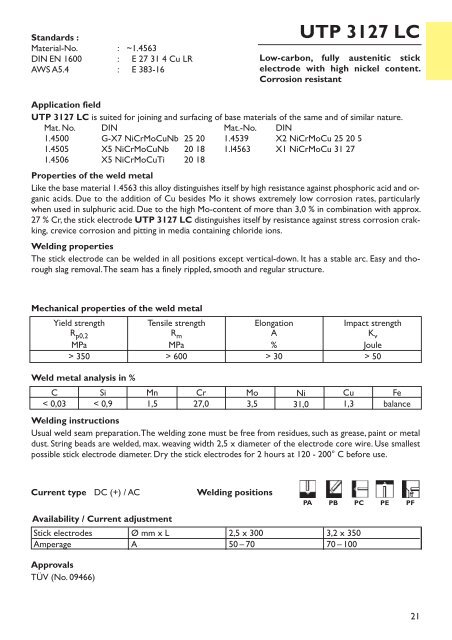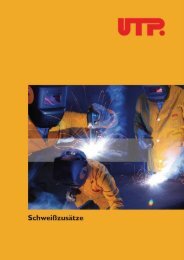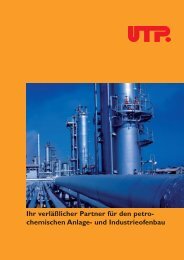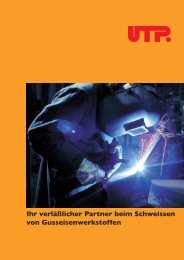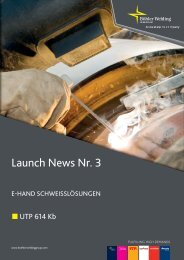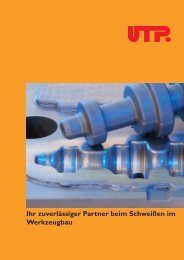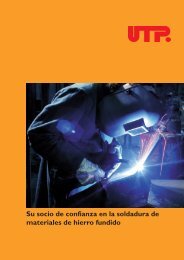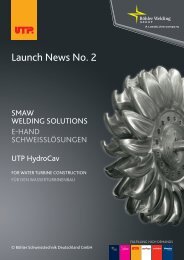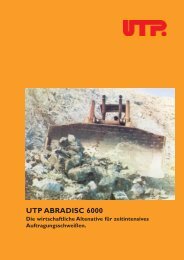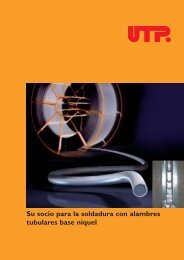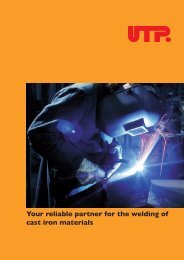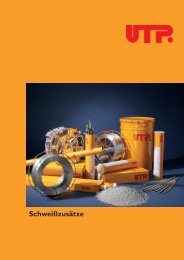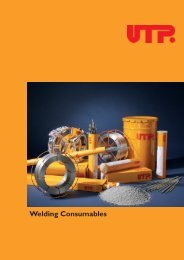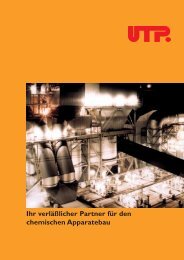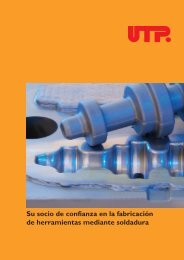- Page 1 and 2: www.utp-welding.com
- Page 3 and 4: WELDING CONSUMABLES
- Page 5 and 6: Index 4 page UTP 3 Product Index 5
- Page 7 and 8: Product Index numerical UTP page 19
- Page 10 and 11: Index High corrosion applications H
- Page 12 and 13: Stick electrodes for high corrosion
- Page 14 and 15: Standards EN ISO 18274 Material-No.
- Page 16 and 17: Solid rods and wires for high tempe
- Page 18 and 19: Solid rods and wires for nickel all
- Page 20 and 21: 19 Welding consumables for nickel a
- Page 24 and 25: Standards : Material-No. : 2.4621 E
- Page 26 and 27: Standards : Material-No. : 2.4887 E
- Page 28 and 29: Standards : Material-No. : 2.4609 E
- Page 30 and 31: Standards : EN ISO 14172 : E Ni 106
- Page 32 and 33: Standards : Material-No.. : 1.4563
- Page 34 and 35: Standards : Material-No. : 1.4591 E
- Page 36 and 37: Standards : Material-No. : 2.4831 E
- Page 38 and 39: Standards : Material-No. : 2.4886 E
- Page 40 and 41: Standard : Material-No. : 2.4607 EN
- Page 42 and 43: Standards : Material-No. : 2.4701 E
- Page 44 and 45: Standards : Material-No. : ~1.4842
- Page 46 and 47: Standards : Material-No. : 1.4853 E
- Page 48 and 49: Standard : Material-No. : 2.4879 EN
- Page 50 and 51: Standards : Material-No. : ~ 2.4680
- Page 52 and 53: Standards : Material-No. : ~ 2.4628
- Page 54 and 55: Standards : Material-No. : 2.4649 E
- Page 56 and 57: Standards : Material-No. : ~ 1.4842
- Page 58 and 59: Standards : Material-No. : 1.4853 E
- Page 60 and 61: Standards : Material-No. : 2.4627 E
- Page 62 and 63: Standards : Material-No. : 2.4649 E
- Page 64 and 65: Standards : Material-No. : 2.4667 E
- Page 66 and 67: Standards : Wire Material-No. : 2.4
- Page 68 and 69: Standards : Material-No. : 2.4807 E
- Page 70 and 71: Standards : Material-No. : 2.4807 E
- Page 72 and 73:
Standards : Material-No. : 2.4625 E
- Page 74 and 75:
Standards : Material-No. : 2.4156 E
- Page 76 and 77:
Standards : Material-No. : 2.4377 E
- Page 78 and 79:
Standard Special alloy UTP A 8036 F
- Page 80 and 81:
Standards : Material-No. : 2.4648 E
- Page 82 and 83:
Standards : Material-No. : 2.4807 E
- Page 84:
Standards Wire Material-No. : 2.480
- Page 89 and 90:
88 General wear protection stick el
- Page 91 and 92:
UTP 7200 E 7-UM-250-KP Basic coated
- Page 93 and 94:
UTP A SUPER DUR W 80 Ni UTP A 34 N
- Page 95 and 96:
SK 350-G SK 258-O SK 600-G SK 650-G
- Page 97 and 98:
UP solid wires / UP flux combinatio
- Page 99 and 100:
UTP 690 E 4-UM-60-ST Rutile coated
- Page 101 and 102:
Gas shielded flux cored wires for t
- Page 103 and 104:
Solid rods on Cobalt base (Cobalt h
- Page 105 and 106:
2.2 104 a) b) Crack welding Crack m
- Page 107 and 108:
2.5 Flux metallurgic fabricated ste
- Page 109 and 110:
Standards : DIN 8555 : E 1-UM-300 E
- Page 111 and 112:
Standards : DIN 8555 : E 1-UM-400 E
- Page 113 and 114:
Standards : DIN 8555 : E 6-UM-60 EN
- Page 115 and 116:
Standards : DIN 8555 : E 7-UM-200-K
- Page 117 and 118:
Standards : DIN 8555 : E 7-UM-250-K
- Page 119 and 120:
Standards : DIN 8555 : E 8-UM-300-C
- Page 121 and 122:
Standards : DIN 8555 : E 10-UM-60-G
- Page 123 and 124:
Standards : DIN 8555 : E 10-UM-65-G
- Page 125 and 126:
Standards : DIN 8555 : ~ E 10-UM-60
- Page 127 and 128:
Standards : DIN 8555 : E 21-UM-65-G
- Page 129 and 130:
Standards : DIN 8555 : E 31-UM-200-
- Page 131 and 132:
Standards : Material-No. : 1.8401 D
- Page 133 and 134:
Standards : Material-No. : 1.4718 D
- Page 135 and 136:
Standards : DIN 8555 : WSG 21-GS-60
- Page 137 and 138:
Standards : Material-No. : ~ 2.0925
- Page 139 and 140:
Standards : DIN 8555 : G 21-GF-60 G
- Page 141 and 142:
UTP-system for mineral wear protect
- Page 143 and 144:
Standards : DIN 8555 : MF 1-GF-250
- Page 145 and 146:
Standards : DIN 8555 : MF 1-GF-350
- Page 147 and 148:
Standards : DIN 8555 : MF 6-GF-60 E
- Page 149 and 150:
Standards : DIN 8555 : MF 6-GF-60-G
- Page 151 and 152:
Standards : DIN 8555 : MF 7-GF-200-
- Page 153 and 154:
Standards : DIN 8555 : MF 8-GF-200-
- Page 155 and 156:
Standards : DIN 8555 : MF 10-GF-65-
- Page 157 and 158:
Standards : DIN 8555 : MF 10-GF-70-
- Page 159 and 160:
Standards : Material-No. : 1.8404 D
- Page 161 and 162:
Standards : Material-No. : Special
- Page 163 and 164:
Standards : Material-No. : Special
- Page 165 and 166:
Standards : Material-No. : 1.4122 D
- Page 167 and 168:
Standards : DIN 8555 : E 3-UM-45-T
- Page 169 and 170:
Standards : DIN 8555 : E 3-UM-45-T
- Page 171 and 172:
Standards : DIN 8555 : E 3-UM-60-ST
- Page 173 and 174:
Standards : DIN 8555 : E 3-UM-350-T
- Page 175 and 176:
Standards : DIN 8555 : E 4-UM-60-ST
- Page 177 and 178:
Standards : DIN 8555 : E 6-UM-60-S
- Page 179 and 180:
Standards : DIN 8555 : E 23-UM-200-
- Page 181 and 182:
Standards : EN 14700 : E Z Ni2 180
- Page 183 and 184:
Standards : Material-No. : Special
- Page 185 and 186:
Standards : Material-No. : 1.2567 D
- Page 187 and 188:
Standards : Material-No. : 1.6356 D
- Page 189 and 190:
Standards : Material-No. : 1.4115 E
- Page 191 and 192:
Standards : DIN 8555 : MF 3-GF-55-S
- Page 193 and 194:
Standards : DIN 8555 : MF 3-GF-40-T
- Page 195 and 196:
Standards : DIN 8555 : MF 3-GF-350-
- Page 197 and 198:
Standards : DIN 8555 : MF 5-GF-45-C
- Page 199 and 200:
Standards : DIN 8555 : MF 23-GF-200
- Page 201 and 202:
Standards : DIN 8555 : E 20-UM-350-
- Page 203 and 204:
Standards : DIN 8555 : E 20-UM-40-C
- Page 205 and 206:
Standards : DIN 8555 : E 20-UM-40-C
- Page 207 and 208:
Standards : DIN 8555 : E 20-UM-50-C
- Page 209 and 210:
Standards : DIN 8555 : E 20-UM-55-C
- Page 211 and 212:
Standards : DIN 8555 : G/WSG 20-G0-
- Page 213 and 214:
Standards : DIN 8555 : ~ G/WSG 20-G
- Page 215 and 216:
Standards : DIN 8555 : MF 20-GF-300
- Page 217 and 218:
Standards : DIN 8555 : MF 20-GF-50-
- Page 219 and 220:
218
- Page 221 and 222:
220 Special alloys stick electrodes
- Page 223 and 224:
UTP 68 HH E Ni 6082 Basic coated, f
- Page 225 and 226:
Standards : Material-No. : 1.4370 D
- Page 227 and 228:
Standards : Material-No. : ~ 1.4337
- Page 229 and 230:
Standards : Material-No. : ~ 1.4337
- Page 231 and 232:
Standards : Material-No. : 2.4648 E
- Page 233 and 234:
Standards : Material-No. : ~ 2.4807
- Page 235 and 236:
Current type : DC (+) Availability
- Page 237 and 238:
Standards : Material-No. : 1.4337 E
- Page 239 and 240:
238 Index Welding consumables for c
- Page 241 and 242:
Stick electrodes for cast iron mate
- Page 243 and 244:
Welding of cast iron materials Appl
- Page 245 and 246:
Standards : EN ISO 1071 : E C Ni-Cl
- Page 247 and 248:
Standards : EN ISO 1071 : ~ E NiCu-
- Page 249 and 250:
Standards : EN ISO 1071 : E C Ni-Cl
- Page 251 and 252:
Standards : EN ISO 1071 : E C NiFe-
- Page 253 and 254:
Standards : EN ISO 1071 : E C NiFe-
- Page 255 and 256:
Standards : EN ISO 1071 : E C NiFe-
- Page 257 and 258:
Standards : EN ISO 1071 : E C Fe-2
- Page 259 and 260:
Standards : EN ISO 1071 : S C NiFe-
- Page 261 and 262:
Standards : EN ISO 1071 : R C Z FeC
- Page 263 and 264:
262
- Page 265 and 266:
264 Welding consumables for copper
- Page 267 and 268:
Solid rods and wires UTP A 38 S Cu
- Page 269 and 270:
The welding of copper and copper al
- Page 271 and 272:
270
- Page 273 and 274:
Standards : Material-No. : 2.1027 D
- Page 275 and 276:
Standards : Material-No. : 2.0837 D
- Page 277 and 278:
Standards : Material-No. : 2.0926 D
- Page 279 and 280:
Standards : DIN 1733 : ~ E 31-UM-30
- Page 281 and 282:
Standards : Material-No. : 2.1211 E
- Page 283 and 284:
Standards : Special alloy Applicati
- Page 285 and 286:
Standards : Material-No. : 2.1022 E
- Page 287 and 288:
Standards : Special alloy 286 CuAlM
- Page 289 and 290:
Standards : Material-No. : 2.0922 E
- Page 291 and 292:
Standards : Material-No. : 2.0923 E
- Page 293 and 294:
Standards : EN ISO 24373 : S CuZ 63
- Page 295 and 296:
Standards : Material-No. : 2.0873 E
- Page 297 and 298:
296 Index Stainless and acid resist
- Page 299 and 300:
Stick electrodes for stainless and
- Page 301 and 302:
Solid rods and wires for stainless
- Page 303 and 304:
Stick electrodes for heat resistant
- Page 305 and 306:
Welding instruction Total cleanline
- Page 307 and 308:
306 Table for use Base materials to
- Page 309 and 310:
308 Table for use Base materials to
- Page 311 and 312:
310 Table for use Base materials to
- Page 313 and 314:
Standards : Material-No. : 1.4551 E
- Page 315 and 316:
Standards : Material-No. : 1.4576 E
- Page 317 and 318:
Standards : Material-No. : ~ 1.4332
- Page 319 and 320:
Standards : Material-No. : 1.4015 E
- Page 321 and 322:
Standards : Material-No. : 1.4351 E
- Page 323 and 324:
Standards : Material-No. : 1.4430 E
- Page 325 and 326:
Standards : Material-No. : 1.4430 E
- Page 327 and 328:
Standards : EN 1600 : ~ E 22 9 3 N
- Page 329 and 330:
Standards : EN 1600 : E 25 9 3 Cu N
- Page 331 and 332:
Standards : EN 1600 : ~ E 23 12 2 L
- Page 333 and 334:
Standards : Material-No. : 1.4455 E
- Page 335 and 336:
Standards : EN 1600 : E 25 22 2 N L
- Page 337 and 338:
Standards : Material-No. : ~ 1.4009
- Page 339 and 340:
Standards : Material-No. : ~ 1.4351
- Page 341 and 342:
Standards : Material-No. : 1.4316 E
- Page 343 and 344:
Standards : Material-No. : 1.4430 E
- Page 345 and 346:
Standards : Material-No. : 1.4332 E
- Page 347 and 348:
Standards : Material-No. : 1.4453 E
- Page 349 and 350:
Standards : Material-No. : 1.4519 E
- Page 351 and 352:
Standards : Material-No. : 1.4351 E
- Page 353 and 354:
Standards : Material-No. : 1.4430 E
- Page 355 and 356:
Standards Wire : Material-No. : 1.4
- Page 357 and 358:
Standards : Material-No. : 1.4302 A
- Page 359 and 360:
Standards : Material-No. : 1.4540 E
- Page 361 and 362:
360 Index Welding consumables for l
- Page 363 and 364:
Stick electrodes for low-alloyed st
- Page 365 and 366:
Standard : EN ISO 2560-A : ~ E 38 0
- Page 367 and 368:
Standard : EN ISO 2560-A : ~ E 42 5
- Page 369 and 370:
Standard : EN ISO 2560-A : E 38 0 R
- Page 371 and 372:
Standard : EN ISO 2560-A : E 50 0 B
- Page 373 and 374:
Standard : Material-No. : 1.5125 EN
- Page 375 and 376:
Standard : EN ISO 16834-A : G Mn3Ni
- Page 377 and 378:
376
- Page 379 and 380:
378 Flame spraying powders UTP EXOB
- Page 381 and 382:
UTP UNIBOND flame spraying powders
- Page 383 and 384:
382
- Page 385 and 386:
384 UTP EXOBOND Flame spraying powd
- Page 387 and 388:
386 UTP EXOBOND Flame spraying powd
- Page 389 and 390:
388 UTP UNIBOND Flame spraying powd
- Page 391 and 392:
390 UTP HABOND Flame spraying powde
- Page 393 and 394:
392 UTP HABOND Flame spraying powde
- Page 395 and 396:
394 UTP HABOND Flame spraying powde
- Page 397 and 398:
396 UTP PTA Metal powders for plasm
- Page 399 and 400:
398 Abbreviations and designations
- Page 401 and 402:
Alloying and Accompanying Elements
- Page 403 and 404:
COBALT ordinal number: 27 crystal s
- Page 405 and 406:
MOLYBDENUM ordinal number: 42 cryst
- Page 407 and 408:
LEAD ordinal number: 82 crystal str
- Page 409 and 410:
TITANIUM ordinal number: 22 crystal
- Page 411 and 412:
410 Brinell Vickers Rockwell 80 85
- Page 413 and 414:
Stress / Pressure : source target 1
- Page 415 and 416:
Work sequences during welding of se
- Page 417 and 418:
Welding positions according to DIN
- Page 419 and 420:
Hardening and annealing temperature
- Page 421 and 422:
Material test certificates accordin
- Page 423 and 424:
422 Wire Basket Spool DIN EN ISO 54
- Page 425 and 426:
Nickel Nickel alloys 80 M, 80 Ni, 1
- Page 427 and 428:
Approvals of UTP welding consumable
- Page 429 and 430:
428 All data on our products contai
- Page 431:
www.utp-welding.com


